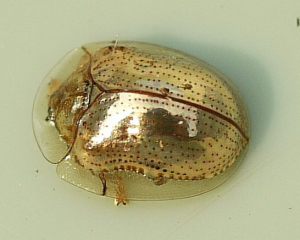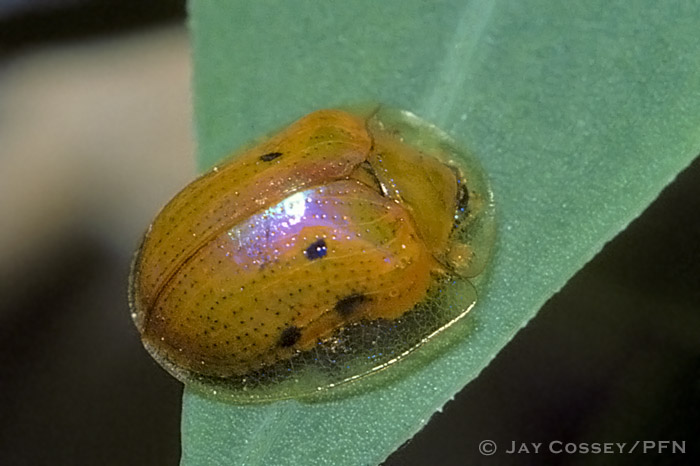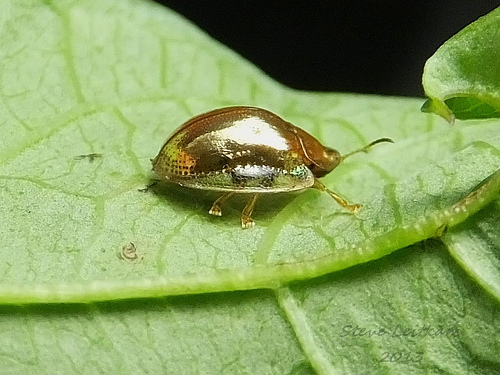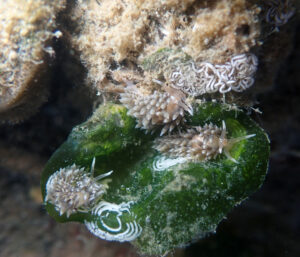This week’s Ask the Naturalist was sent in by Arlene Nielson from Clayton who happened upon a little speck of treasure in a most unlikely place:
Around five years ago I found a golden metallic beetle in my home once that was exactly like a lady bird beetle. I thought I had broken a piece of gold jewelry and had dropped it on the carpet but when I went to pick it up I found out it was alive! I kept it in an insect carrier for a bit with some leaves and eventually released it outdoors. Can you tell me something about this beetle? I’ve never seen one before.

Several shiny suspects come to mind: The glorious scarab beetle, Chrysina gloriosa, and the sunset-colored golden jewel beetle, Buprestis aurulenta, are both common in California, but neither species looks like a golden ladybird beetle. Most likely this carpet-braving bandit is a tortoise beetle, specifically — you guessed it! — the golden tortoise beetle, Charidotella sexpunctata.
Golden tortoise beetles look similar to lady bird beetles (the Coccinellidae family), but actually belong to the Chrysomelidae, or leaf beetles: a huge family whose 37,000 members can be found munching on plants all over the world.
Tortoise beetles get their funny name from the peculiar structure of their elytra — the hardened wing covers that protect the flying wings in beetles — which have a flattened ridge outlining the body and concealing the head and legs, much like a tortoise. Entomologists suspect this feature allows them to hunker down and tuck in their body parts when under attack from a predator.
The golden tortoise beetle is common in North America and can often be found in backyards on plants such as sweet potato and morning glory.
But golden tortoise beetles aren’t always so golden. In fact, they can change color depending on the season or even their mood using the liquid beneath their transparent shell. Underneath the shell are three layers of cuticle, each covered in tiny nooks and crannies that appear smooth when covered with liquid, and reflect light perfectly like a mirror. But when a golden tortoise beetle is agitated or under attack from a predator, it contracts the spaces between the layers of cuticle and forces liquid out of the grooves — doing away with the iridescence and usually revealing a brownish-orange color.

This sort of rapid color-change is very rare in insects, but also occurs in the Panamanian Tortoise Beetle, and the grasshopper genus Kosciuscola (which changes color in response to ambient temperature).
Golden tortoise beetles also change color depending on the availability of their liquid layer. During drier months the beetles become less lustrous and are more orange and bronze with flashes of iridescence.
Throughout North America, populations of golden tortoise beetles can look quite different, which has led to some confusion and multiple names for the same species. Many individuals also have black spots on the outside of their shell, which adds to their appearance as a golden lady bird beetle.
Dave Kavanaugh, the curator of beetles at the California Academy of Sciences, has seen the many colors of the golden tortoise beetle in the field.
“They are really cool — they can be metallic, red, orange, or even greenish,” he said. “They change colors when they are stressed or disturbed, but they are good when they are golden.” Rachel Diaz-Bastin is a Scientific Illustrator in the Department of Entomology at the California Academy of Sciences.
A bird? A bug? Something strange in the natural world nearby? Ask us and we’ll find the answer!





